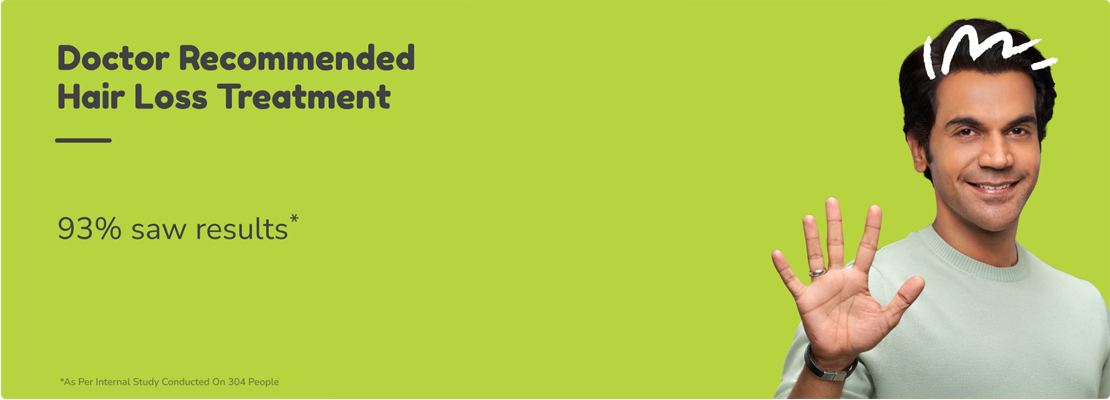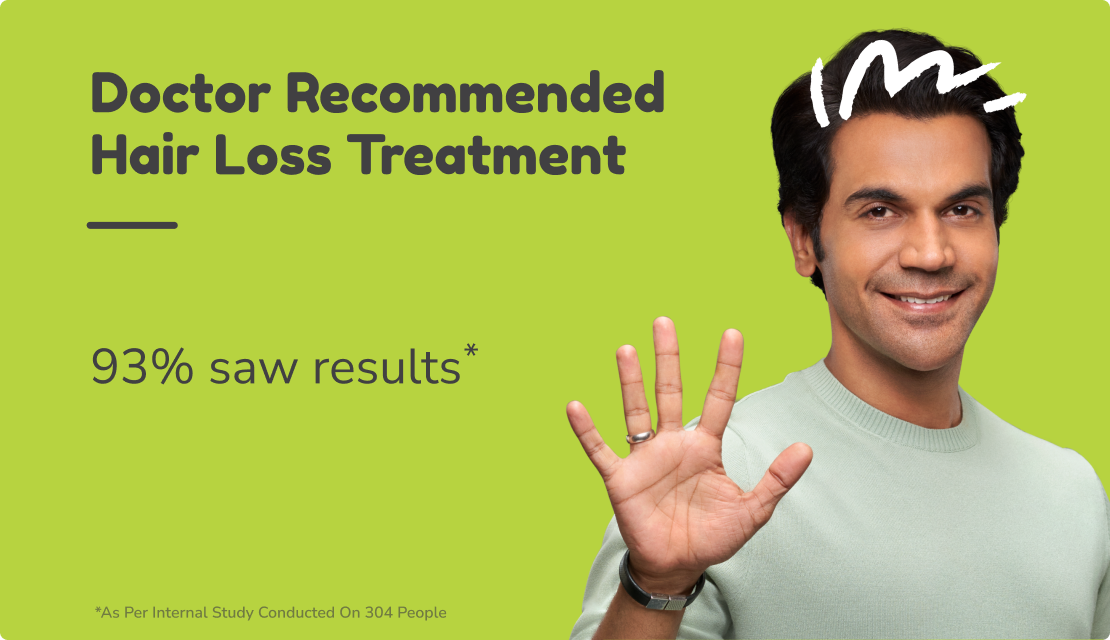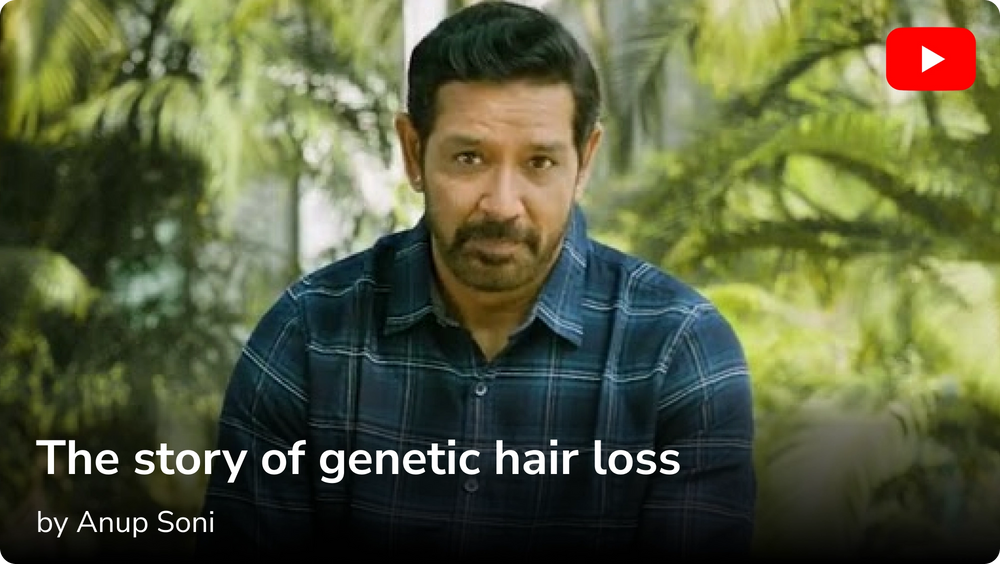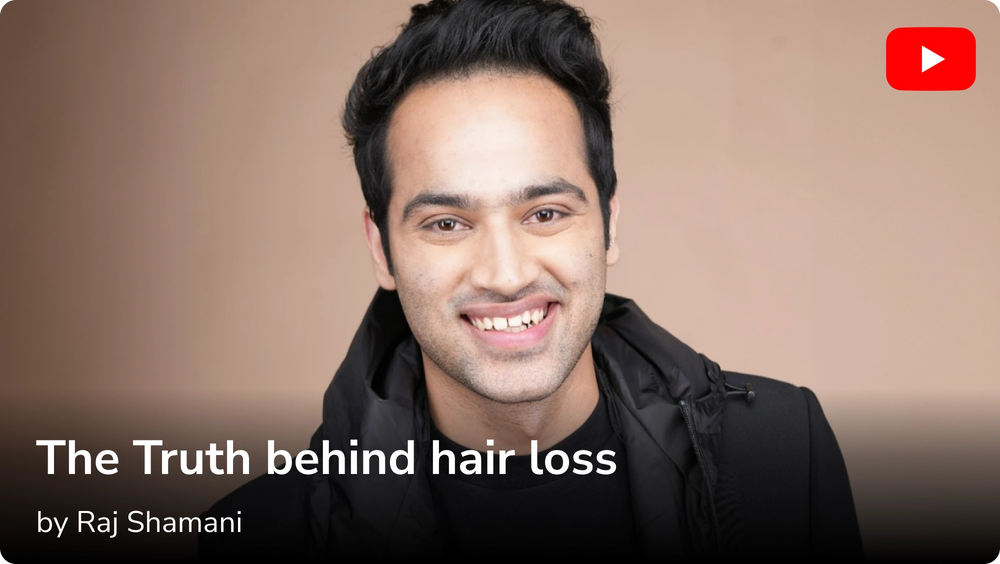Does your hair look like the above image? It is because you have low hair density.
Hair density refers to the number of hair follicles on the scalp and the amount of hair strands present in each area of the scalp. Think of it like this: If you place your hand on one part of your scalp, the “density” would be the number of hair on it. If you feel fewer stands than you would like, you can say you have low hair density (and vice-versa).
Increasing your hair density requires a holistic approach- right from giving your body the important nutrients and hydration it requires to external care with oils, massages and chemical free products, it is a continuous process. Eating foods rich in protein, vitamins and minerals helps with increasing hair density and improving the quality of your hair.

Hair density is a significant factor in determining the fullness and thickness of one's hair. Hair density varies from person to person, and factors such as genetics, age, and overall health can influence it.
Hair density is commonly categorised into three main types: low, medium, and high.
- Thin or low-density hair is characterised by a flat and light appearance, often lacking the volume associated with thicker hair.
- Medium-density hair strikes a balance between the flatness of low-density and the robust fullness of high-density hair. This type showcases a more voluminous and textured look compared to low-density hair.
- High-density hair is often viewed as a symbol of beauty and health. It appears full and thick, with a richness in the number of hair strands present.
Do Genetics matter?
Genetics does play a crucial role in determining hair density, but other factors can impact it, such as hormonal imbalances, nutritional deficiencies, and medical conditions. Nurturing and caring for your unique hair characteristics, whether you have high or low hair density, is important for promoting overall hair health and well-being. “How to increase hair density” is a question that bothers many of us. The answer simple answer is- to identify the cause of low hair density and take steps in the correct direction to promote hair growth. If you wish to find out the cause, you can take a simple Hair Test by Traya that takes just 2 minutes and helps you to improve your hair problem with a personalised kit.
How to Increase Hair Density?
Enhancing hair density naturally involves adopting a holistic approach that addresses internal and external factors affecting hair health.
1. How to increase hair density by food
Your health is a reflection of what you eat. Improving your diet is one of the first steps to improve hair density naturally. Ensure your diet includes a variety of nutrients essential for hair health through foods for hair growth as listed below:
- Protein: Hair is primarily made of protein. Include eggs, lean meats, and legumes for strong and healthy hair.
- Vitamins: Vitamin A promotes sebum production, Vitamin C aids in collagen formation, and Vitamin E acts as an antioxidant. You can include carrots, citrus fruits, and nuts to improve Vitamin A and C levels.
- Minerals: Iron and zinc are crucial for hair growth. Incorporate lean meats, legumes, and seeds to meet these nutritional needs.
- Omega-3 Fatty Acids: In fatty fish, flaxseeds, and walnuts, omega-3s support scalp health and add shine to hair. Omega 3 supplements available in tablets can also be considered viable options.
Also Read: Foods for hair growth.
2. Hydration
Drink an adequate amount of water to maintain overall health, including that of your hair. Proper hydration helps nutrients to reach hair follicles and maintain scalp health. Dehydration can make hair dry and brittle, thus making hair more prone to breakage.
3. Scalp Massage
Scalp massages are known to encourage hair growth. Regularly massage your scalp to improve blood circulation. This can be done with your fingertips or a gentle scalp massager, moving in circular motions. Improved blood flow to the hair follicles encourages healthy hair growth.
4. Gentle Hair Care
Use a mild, sulphate-free shampoo and conditioner suitable for your hair type. Avoid excessive washing, as it can strip the scalp of natural oils needed for healthy hair. Be gentle while brushing to prevent hair breakage, and use a wide tooth comb to minimise breakage.
5. Natural Oils
Apply natural oils like coconut, olive, or argan oil to nourish the hair and scalp. These oils provide essential fatty acids and moisture, promoting healthier, thicker hair. Coconut oil is known for its moisturising properties, which can reduce protein loss in hair. Olive Oil and Argan Oil add shine and provide essential fatty acids for healthier hair. These oils can be incorporated into your hair care regimen through scalp massages or hair masks.
6. Proper Hair Styling
Avoid tight hairstyles as they may cause tension on the hair shaft, leading to a condition known as traction alopecia. Instead of tight hairstyles, opt for looser styles that minimise stress on the hair. Limit harsh chemical treatments, such as perms, relaxers, and excessive colouring Minimize the use of heat styling tools, and when styling with heat, use heat protectants to shield your hair from damage.
7. Physical activity
Physical activity is beneficial for overall health Regular exercise enhances blood circulation, which can benefit the scalp and hair follicles by ensuring a proper supply of nutrients.
8. Consider Taking Supplements
If you are unable to take care of your body's nutritional requirements through food, you can opt for Nutritional supplements. Traya's hair vitamin is one such supplement that has Biotin and 18 other nutritional supplements which can help you improve your hair density.
Causes of Low Hair Density
1. Genetic Factors
Hair loss often has a hereditary factor, with a strong genetic influence on whether an individual will experience thinning hair. If your parents or grandparents had hair density issues, you might also be more prone to it.
2. Hormonal Imbalances
Hormones are critical in regulating various bodily functions, including hair growth. Fluctuations in hormones, particularly during significant life events like menopause or postpartum, can lead to imbalances that result in hair thinning.
3. Medical Treatments
Certain medical treatments, especially chemotherapy, can have the unintended side effect of causing temporary hair loss. While the primary goal of such treatments is to combat illnesses, the impact on hair density can be challenging for many.
4. Stress
The mind-body connection is evident when it comes to stress and hair loss. Both emotional and physical stress can induce a condition known as telogen effluvium, where hair follicles prematurely enter the resting phase, leading to significant hair shedding.
5. Hairstyling Practices
Our daily hairstyling routines can also contribute to low hair density. Tight hairstyles, such as braids or ponytails, and frequent heat treatments can cause traction alopecia, a form of hair loss resulting from continuous tension on the hair shafts.
6. Nutritional Deficiencies
The saying "you are what you eat" also holds for hair health. Inadequate intake of essential nutrients, including vitamins and minerals, can deprive hair follicles of the nourishment they need for optimal growth, contributing to low hair density.
7. Environmental Factors
External elements, such as pollution exposure and harsh weather conditions, can affect our hair health. Pollution, UV rays, and extreme weather can contribute to hair damage and thinning.
8. Underlying Health Conditions
Certain medical conditions, including thyroid disorders and autoimmune diseases, can impact hair density. Addressing the underlying health issue is crucial in managing and potentially reversing hair loss.
When to Seek Expert Advice on Hair Fall
If you are experiencing Sudden and Severe Hair Loss and baldness, especially if it follows a hereditary pattern, advice can help determine appropriate treatments. Certain medications can cause hair loss as a side effect. If you are on medication and notice significant hair shedding, consult your doctor to rule out the cause of hair fall. Most of the time, hair loss is a symptom of an underlying health condition such as thyroid disorders or autoimmune diseases; these conditions require the attention of a medical professional.
If you cannot determine the cause of your hair fall or seek an effective solution, you can take Traya’s free Hair Test to treat hair fall from its root cause.
Conclusion
Improving hair density naturally is all about changing one's lifestyle to create better habits, a proper hair care routine, and a nutrient-rich diet. Initially, it could be difficult to incorporate hair care practices into one’s busy schedule but try to create a system within your day that gives hair care its due space. Focusing on both the internal as well as external aspects affecting hair is the best approach to increasing hair density
Hair growth is a gradual process, and results may take time. It's essential to adopt these practices consistently and patiently for optimum results. Be patient and consistent with your natural hair care routine, allowing the hair growth cycle to unfold naturally. Consistency is key to seeing positive changes in hair density over time.
People Also Ask:
Q. Can Hair Density Be Increased?
Genetic factors primarily determine hair density, and while it's challenging to alter your natural hair thickness significantly, certain measures can enhance the appearance and health of your existing hair. Adopting a healthy lifestyle, proper hair care, and targeted treatments can contribute to fuller-looking hair. However, it's essential to have realistic expectations, as the extent of improvement varies among individuals.
Q. What are the Reasons Behind Reduced Hair Density
Reduced hair density can be attributed to various factors, including genetics, hormonal imbalances, nutritional deficiencies, stress, and environmental influences. Identifying the specific cause is crucial in determining the most effective strategies for addressing and potentially improving hair density. Consultation with a healthcare professional or a dermatologist can help pinpoint the underlying issues and guide a tailored approach.
Q. What are some natural methods for Hair Thickening?
Several natural methods can contribute to the thickening of hair. Regular scalp massages improve blood circulation, promoting healthy hair growth. Natural oils, such as coconut or argan oil, can provide essential nutrients and moisture. Additionally, incorporating herbs like aloe vera or ginseng into your hair care routine may support overall hair health. While these methods may not drastically increase hair density, they can enhance thickness and vitality over time.
Q. How can I get my hair volume back?
Restoring hair volume involves a multifaceted approach. Choosing volumising hair care products, such as shampoos and conditioners, can create the illusion of fuller hair. Proper styling techniques can add lift, like blow-drying with a round brush or using volumising mousse. Regular trims prevent split ends, maintaining the overall health and thickness of the hair. Hair extensions or volumising haircuts can temporarily boost volume for those seeking more immediate results.
Q. How to Increase Hair Density Naturally at Home
Increasing hair density naturally at home involves a combination of lifestyle adjustments and targeted treatments. Adopt a nutrient-rich diet with foods containing vitamins (A, C, E), minerals (iron, zinc), and omega-3 fatty acids. Stay hydrated, manage stress through relaxation techniques, and incorporate scalp massages into your routine to improve blood circulation. Natural remedies like aloe vera gel or onion juice, known for their potential hair-stimulating properties, can be applied topically.
Q. How to Increase Hair Density by Food
Nutrition plays a crucial role in maintaining healthy hair density. Include foods rich in biotin (eggs, nuts), iron (spinach, red meat), omega-3 fatty acids (fatty fish, flaxseeds), and vitamins (fruits and vegetables) in your diet. These nutrients support the hair growth cycle and contribute to overall hair health. Additionally, stay mindful of your protein intake, as hair is primarily protein-based. A well-balanced diet ensures your body receives the essential building blocks for strong and dense hair.






































